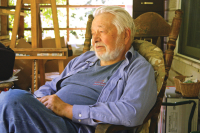New book takes closer look at baskets and their makers
Anna Fariello believes that artifacts — somewhat like windows — can act as passageways to a culture’s soul.
“Material culture can be a window onto the changes that occur in social and cultural history,” said Fariello, an associate professor and chief architect of the Craft Revival Project at Western Carolina University’s Hunter Library.
An author, editor and former research fellow at the Smithsonian Museum of American Art, Fariello most recently turned her attention to Cherokee basketry, a thousands-year-old tradition, passed from mother to daughter, that she believes is integral to Cherokee culture.
Fariello’s new book, titled Cherokee Basketry: From the Hands of our Elders, studies Cherokee baskets and basket-makers who lived during the first half of the 20th century.
The project reinforced Fariello’s understanding that for Cherokee people, “the making of things is significant to their culture and their identity,” a concept foreign to many people in contemporary, mainstream culture, she said. The Cherokees’ use of natural resources as basket materials gave Fariello an appreciation of the environmental sustainability and ecological balance also inherent in the culture.
The Eastern Band of Cherokee Indians played a significant role in the craft revival, a regional movement in the late 19th and early 20th centuries that produced a wealth of objects, identified traditional skills, and revitalized handwork production in Western North Carolina.
Related Items
With a grant from the State Library of North Carolina, Fariello originally set out to expand the information available on the project’s site, which chronicles the movement and its impact on Western North Carolina through text and images.
Fariello worked with the Qualla Arts and Crafts Mutual and the Museum of the Cherokee Indian in Cherokee with the purpose of making their collections available online.
A grant of $47,000 from the Cherokee Preservation Foundation added a second element to the project: to research and more fully document basketry in those collections.
While the project did not start out as a book, Fariello said it seemed the logical conclusion. “The book takes scattered elements and arranges them for a more complete picture,” she said.
Cherokee Basketry examines specifics about basket-makers themselves, how baskets were made, and what they were used for. Archival photographs illustrate “Cherokee Basketry,” published by The History Press of Charleston, S.C.
“I hope that this book has a broad audience,” Fariello said. “I think it can serve as a classroom text for Cherokee studies or the visual arts, and I also think it will have a broad public appeal for anyone interested in regional culture, especially the influence of the Cherokees on Western North Carolina.”
Fariello presented books to Eastern Band of Cherokee Indians Chief Michell Hicks and the Tribal Council. Fariello also gave 200 copies of the book to Cherokee School Superintendent Joyce Dugan for teachers to use in the Eastern Band’s new K-12 school.
The project was a great service to the Qualla Arts and Crafts Mutual, whose permanent collection has more than 100 baskets and continues to grow.
“Before the archive organization, the only recorded information in our permanent collection was a handwritten line about each item,” said Vicki Cruz, manager of the Qualla Arts and Crafts Mutual.
Now the co-op’s archives are digitized and include contemporary photos, as well as information about dimensions, materials and patterns, and the artists themselves.
Fariello also worked with co-op employees on the care and display of the baskets, and about recordkeeping when a new piece enters the collection.
Cruz said she eventually plans to use her new knowledge to document the work of contemporary basket-makers. “The daughters of basket-makers Agnes Welch and Eva Wolfe, they’re basket-makers too, and now their daughters are starting to weave,” she said.
The basketry book is the first in the “From the Hands of our Elders” series, a three-year project to document Cherokee arts.
The next book, funded with $87,770 from the Cherokee Preservation Foundation, will focus on Cherokee potters and pottery during the first part of the 20th century. A book on Cherokee woodcarving and mask making is scheduled to follow.
For more information about the “From the Hands of our Elders” series or the Craft Revival Web site, contact Fariello at 828.227.2499 or This email address is being protected from spambots. You need JavaScript enabled to view it..









